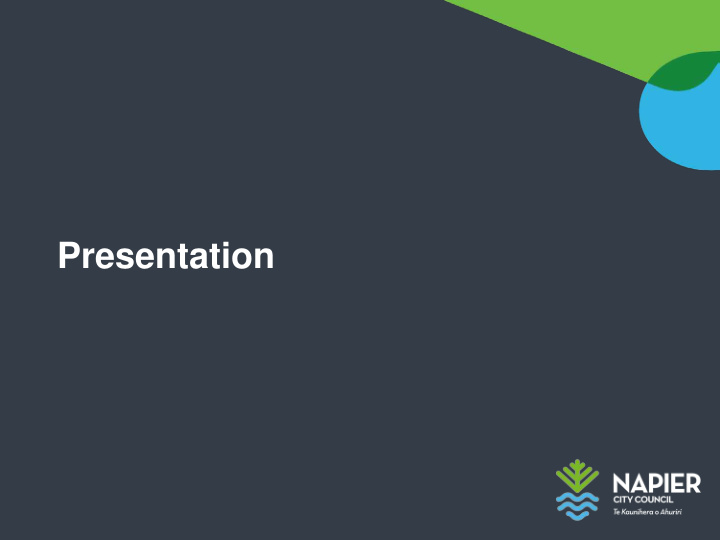



Presentation
Water at a Glance • Water take from Heretaunga Plains aquifer • Water is provided for: • Domestic needs • Commercial/business/industrial needs • Fire fighting needs • Current city population approximately 61,000 • Napier is a medium growth area • Two distinct supply areas • Napier supply area (universally metered) • Bay View supply area (high water users are metered) • Water permit expires in 2027
Asset Types • Bores – 10 (9 in operation) • Pipes – 481 km • Reservoirs – 11 (on 8 sites, approximate storage 29,000,000 litres, average 24 hour usage) • Booster pump stations – 8 • Total Water Connections – 25,550
Scheme Schematic
Consented Volumes vs Actuals and Projections Condition Allowed limits Current Estimated 2048 Estimated 2048 of take maximum take maximum take maximum take, from all bores no change in targeted future per capita per capita consumption, consumption 440 l/pers./day 300 l/pers./day (excluding wet (excluding wet industries) industries) Cumulative rate 784 litres/sec 606 litres/sec 790 litres/sec <600 litres/sec of take of water from all bores Cumulative 7 387,744 cubic 283,000 327,550 223,325 day maximum meters take from all bores
Population Growth: HPUDS and NPS - UDC • Local authorities shall ensure that there is sufficient housing and business land development capacity in the short (3 years), medium (3-10 years) and long term (10 – 30 years) • Development capacity means the provision of adequate infrastructure (water supply, wastewater and stormwater) • Degree of conflict between NPS - FWM and NPS - UDC
Water Conservation Strategy • Public education • Pressure management • District zoning and monitoring • Targeted leak detection • Dedicated water taking points • Asset renewals • Water restrictions • Benchmarking with Water NZ • Annual water balance report • Universal water metering (long term option – decision of Council)
Targeted per Capita Consumption (gross) Year Current Aspirational Targeted How we are achieving the consumption consumption target litres/capita/day litres/capita/day 2018 440 N/A N/A 2023 N/A 425 Water conservation strategy, no universal metering 2028 N/A 400 Water conservation strategy, no universal metering 2033 N/A 300 Water conservation strategy, universal metering 2038 N/A 300 Water conservation strategy, universal metering 2043 N/A 300 Water conservation strategy, universal metering 2048 N/A 300 Water conservation strategy, universal metering
Projections
Water Quality • Major focus • Sources of contamination • Catchment – land use, existing bores, decommissioned/unused bores, spillages • Bores – bore structure, headworks, proximity of sewer system • Reservoirs – vermin/contaminants entry points • Reticulation – backflow, pipe breaks
Priorities • Catchment protection – working together with other stakeholders • Water conservation – sustainable water source • Enable growth – minimise usage and waste to cater future demand • Water treatment
Capital Investments next 30 years • Water quality improvements - $9.6 million • Future demand - $20.6 million • Improve level of service (flow, pressure)- $2 million • Renewals - $45.2 million
Future urban water focus • Support sustainable use of the aquifer • Support fair and equitable approach… • Support future population growth • Support economic development • Recognise cultural values
STORMWATER
Stormwater at a Glance • Majority of catchment flat and low lying • 13 sub-catchments (total of 6,055 ha) • Drainage is extensively reliant upon an open drain system • Approximately 68% of stormwater discharged into Estuary • Approximately 75% of stormwater pumped into Estuary or sea
Stormwater catchment
Desired Standards for Network capacity • Provide flood protection from rain event of 50 year return period • Primary stormwater system designed to convey stormwater from a rain event of 10 year return period • Secondary stormwater system designed to convey stormwater from a rain event of 50 year return period • No adverse effect on receiving environment
Stormwater Issues • Currently can not meet the desired standards in many areas • Uncertainties over ownership of some stormwater assets • Stormwater quality issues • Growth pressure • Climate change
What is Planned? • Construction of a 2D hydraulic model • Develop a master plan for the next 30 years to meet the desired standards • Improve water quality • Ahuriri Master Plan • Catchment Management Plans • Promote low impact design concepts • Updated District Plan • Review of Engineering Code of Practice
30 Year Capital Investment Programme • Improve level of service • Discharge quality improvements - $11.7 million • Capacity improvements - $24.3 million • Growth - $24.9 million • Renewals - $25.9 million
Opportunities
Stormwater CycleOpportunities
Opportunities
Opportunities
Opportunities
Recommend
More recommend